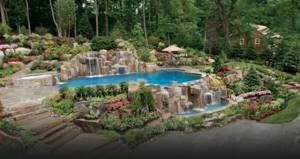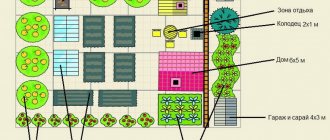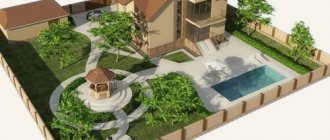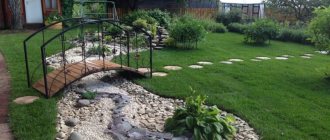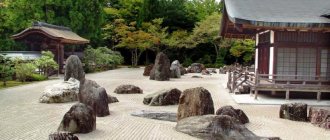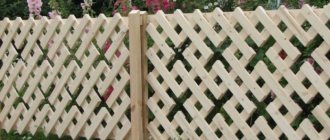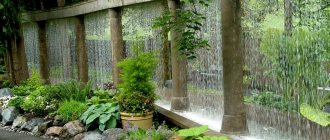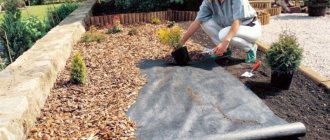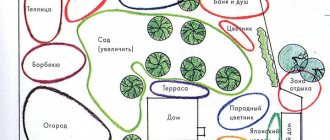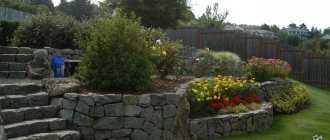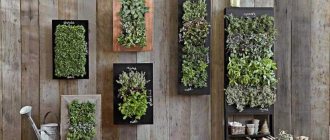Many of us often wonder why, even if there are a large number of expensive decorative elements and plants in the garden plot, it still doesn’t look good? One of the main reasons for this is that the garden does not have a design or, in other words, a landscape style.
It is likely that no one will immediately be able to unequivocally answer the question of what style he prefers to see in his garden, but this is not necessary. In the process of designing landscape design, an understanding of human preferences appears, the opportunity to feel the mood and image of the future garden.
There is no need to be strictly attached to generally accepted stylization, for example, a Japanese or English garden, a country-style garden, and others. The main thing is to determine the basic elements for yourself, and then comes improvisation using fantasy and imagination. But to choose even the basic elements of a landscape design style, you need to at least know what to choose from.
Based on the above, it is worth getting acquainted with the main styles of landscape design.
Landscape or English garden
Landscape style in landscape design excludes the presence of strict forms and, at the same time, emphasizes the maximum naturalness of the landscape. In the process of creating it and developing the design, you will have to completely abandon the correct geometric shapes. As a result, all elements must be in perfect harmony and merge with the surrounding nature. In other words, partial intervention in the nature of the landscape is assumed, while taking into account the prevailing vegetation in your area.
English garden design elements
This landscape style is characterized by the following elements:
- Ponds that have a natural shape with water lilies or lilies.
- A bridge over a pond and benches next to a pond made of natural materials.
- Winding paths made of natural materials, cut wood or stone.
- Availability of quality lawn.
- Predominance of green and silver colors.
- The presence of vertical gardening elements.
- Areas of the territory are filled with flowers, among which daffodils and crocuses, tulips and pansies, hollyhocks and roses are clearly visible. Flowers should be planted in groups to add splendor to the composition.
- The obligatory presence of decorative willow and boxwood, thuja and juniper, jasmine and elderberry.
The English style in landscape design requires constant care.
Landscape design in landscape style
The landscape style in landscape design was formed later than the previous one. It is also called English, natural, natural or free. It is not for nothing that it arose after the regular style, since it is a direct protest of what is typical for the regular style. The English style in landscape design promotes imitation of nature. The main task is to create a landscape that is in no way different from the natural one.
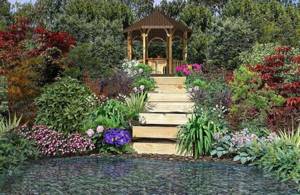
Here are the main characteristic features of this stylistic direction:
- use of natural resources;
- man lives in harmony with nature, it dominates;
- direct imitation of nature;
- the finished landscape should be as similar to the natural one as possible.
If we talk about paths, they do not lead strictly along a specific line. They are smooth and a person who walks along them comes from one landscape to another. Everything that is in nature should be in this landscape design. At the same time, placement should not be strict and in a certain order. If we talk about specific examples, several parks in this style have been preserved in the CIS. These are Pavlovsky and Catherine Parks near St. Petersburg, Moscow Tsaritsinsky Park, Sofievka and Alexandria in Ukraine.
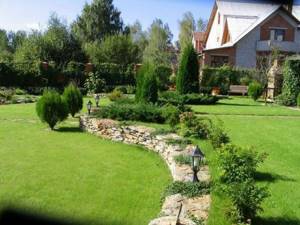
Classic or regular style

Regular (classical) style in terms of landscape design involves strict symmetries, geometric and clear shapes. If shrubs are used, they must be perfectly trimmed; this rule also applies to trees. The classic style in landscape design completely excludes naturalness. The main emphasis is on the artificiality of landscape design.
Features of the classic landscape style
The following design elements stand out:
- Flowerbeds with a strict shape.
- Ponds and fountains in the center of the garden plot.
- Straight alleys and paths.
- Gazebos at the intersection of paths - they should have a round shape and imitate an ancient Greek portico.
- Natural materials.
- Preference is given to topiary plants. Spherical thuja and maple, linden and pyramidal juniper, jasmine and lilac, as well as maiden grapes are planted.
- When arranging flower beds, it is advisable to use different flowers (salvia and phlox, begonias and roses).
- Use of forged benches.
- Pergolas.
- Decorations include arches, Greek flowerpots with legs, classical columns and stone balls, and antique sculptures.
Spanish style - photo and description
The Spanish style of landscape design has been greatly influenced by Islamic, Persian and Moorish landscaping traditions. Originating in Spain, this style is now popular throughout the world, especially in areas with similar hot and dry climates. The Spanish style of landscape design has improved the principle of dividing space and creating closed areas. Patios, terraces overlooking the landscape, fountains - all these are features of the Spanish style.
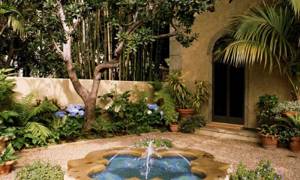
Water must be present in the Spanish landscape. Fountains and the use of water are extremely important features in the Spanish style. The courtyards are designed down to the smallest detail. Decorative ponds of regular geometric shape with symmetrical flower beds around can replace fountains. Symmetry is one of the main elements of the Spanish garden.
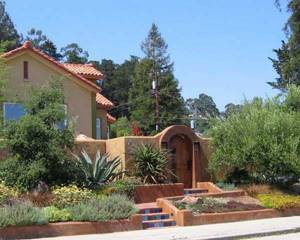
The basis of the Spanish landscape is made up of drought-resistant plants. Ceramic tiles are widely used; with their help, almost any small architectural forms and design elements are created, such as built-in benches, fountains, ponds, retaining walls, paths, etc. Large terracotta pots with bright blue glaze are also a must-have decorative element.
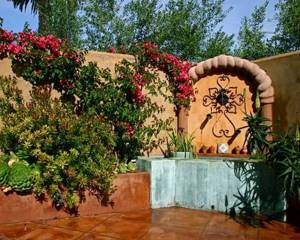
| Decor elements | Materials used | Characteristic plants |
|
|
|
I hope this short guide to landscape design styles helped you decide on the choice of style for your summer cottage, and the photos and descriptions of the styles directed your creativity in the right direction. Good luck in creating something beautiful!
Scandinavian style
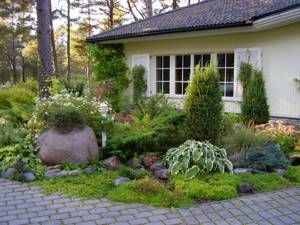
For the Scandinavian style in landscape design, any terrain and location of the site is suitable. Here it would be useful to look at photographs from northern European countries that reflect local life and landscape. The northern countries are characterized by tranquility and mountains in the background in the distance, foggy haze and Norwegian fjords, a feeling of unity with nature and distance from the noise of civilization. In general, this style, like Scandinavia itself, can be associated with restraint, orderliness, functionality and simplicity. But you should not neglect bright, colorful accents in the form of flower beds or variegated compositions of shrubs.
Features of the Scandinavian style
Scandinavian style in landscape design has a number of distinctive features:
- Flowers planted in containers.
- Presence of Spanish-Moorish lawn.
- Reservoirs of various shapes.
- Heather garden.
- Oases and clearings for the growth of wild plants.
- Hedges that act as fences and barriers.
- Maximum open space (territory).
Country - “rustic” landscape style
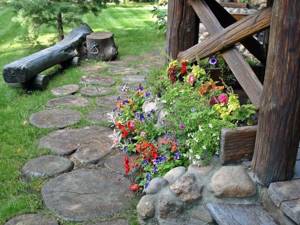
Landscape design in country style is currently the most common. This popularity is explained by the simplicity, naturalness and ease of this landscape style. This “rustic” style assumes the absence of strict lines, as well as strict rules when designing the landscape.
The style predominantly uses bright colors. When creating a landscape project in this style, priority will be given to natural materials, such as lining and wicker, timber and metal, stone and gravel, as well as wood. Often the area of the site is planted with fruit trees, such as plum or cherry. It is also possible to plant medicinal plants such as mint and thyme, marigolds and thyme. Shrubs such as bird cherry, lilac, viburnum and others are also popular in this style. In other words, everything that is popular in an ordinary village.
When landscaping an area in a country style, you should give preference to plants that require the least care.
Country style accessories
Rustic style in landscape design requires the presence of all kinds of decorative elements, which can be:
- Accessories and handicrafts.
- Original flower beds.
- Carts and wheels.
- Metal or wooden benches.
- Birdhouses or feeders.
- Wicker or hedge.
- Decorative wells.
- Pet figurines.
Landscaping in the Dutch style
The Dutch style in landscape design in our area is not as popular as the others. This is the design option that is suitable for arranging spacious areas. The Dutch garden is very charismatic and charming. It includes bright colors, various accessories, home warmth and comfort.
Finding out this direction is quite simple. It is based on a ground lawn, which is the pride of the owners. A hedge or mixborder is planted near the lawn. In the center of the lawn there may be some additional elements, a statue, a fountain or a tree. The center of the composition is the house. It is moved away from the central entrance in order to allocate space used for creating flower beds and flower beds. They will decorate the house. Most often, the walls of the building are covered with grapes or ivy.
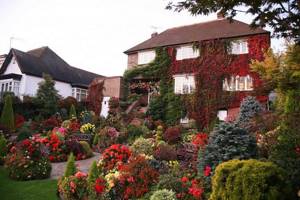
Note! There may not be many trees in this composition. But those that exist are an example of well-groomed conditions. The owners put a lot of effort into caring for it. Tree crowns are constantly trimmed and all dry branches are removed.
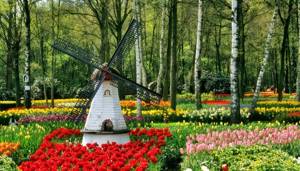
Another feature of the Dutch style is elements of rural life. For example, some people install a wooden wheelbarrow, decorating it with flowers or vegetables, a small wooden mill or a neat well.
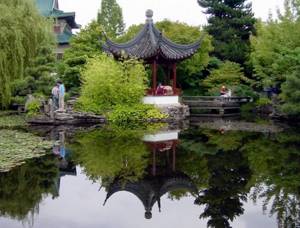
Art Nouveau style
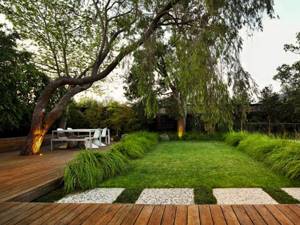
Art Nouveau style in landscape design is the design of a house in harmony with the surrounding area, where plant compositions are used to decorate the building, while the lines of the building’s facade are repeated in the garden.
Particular attention is paid here to small architectural structures and all kinds of accessories.
Decorative plants and flowers fade into the background, while at the same time a perfect combination of all items in the design is necessary. Designing a garden area in this style requires good and regular landscape maintenance.
Features of the Art Nouveau style
Landscapes in the Art Nouveau style suggest arched shapes and lines that smoothly intersect with each other. It is also possible to repeat certain designs when we are talking, for example, about paths, flower beds and other elements. The main element of the landscape is the house; all kinds of spirals and other elements come from it, like rays from the sun.
Here preference is given to natural materials. The color palette in this design project is very diverse and includes blue, beige, black, chocolate, silver, yellow, red and purple. When installing outdoor furniture, it is recommended to make it by forging. A good solution would be to organize a small fountain or stream. Taken together, all of the above will emphasize this type of landscape design.
Minimalism style
The direction was founded in 1917 in the Netherlands. Key concepts: common sense, brevity, sharpness and specificity in the smallest nuances. Japanese creativity and design greatly influenced the formation.
Striving in various areas of art, which is specific to the clarity of contours, strict lines, simplicity of elements, natural materials and extraordinary floral solutions. The task of the surroundings is to combine simplicity and practicality. This can be achieved using special lighting and geometric contours. Minimalism is extreme simplicity combined with elegance and sophistication.
Peculiarities
- Distinct lines of each object.
- The zones are separated by natural differences.
- Buildings for household needs are practically absent or hidden from the all-seeing eye.
- A geometric body of water, most often one.
- Lots of paved surfaces.
- Few details. But, if there are, then these are abstract sculptures, balls, mirrors or unusual wire sculptures.
- There may be no lawn, and the presence of flower beds may be very small. Basically, these are elevated areas. There is no vertical gardening. Most often, what is available is decorated.
- The minimalist style assumes a restrained palette of colors. These are soft colors and their shades. The presence of bright accents is limited.
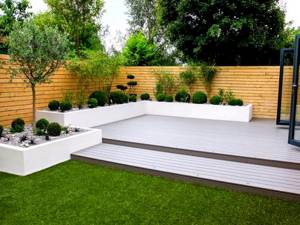
landscape in minimalist style
Philosophy of Japan
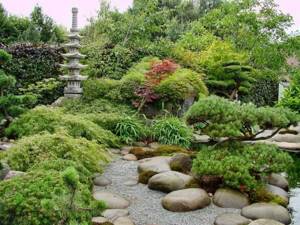
Landscape design in Japanese style always contains a certain mystery. We can safely say that Japanese style is a real philosophy, where the key elements are stones, plants and water. This style emphasizes the ideal harmony and balance of all components of the landscape, and the elements used should have different shapes, sizes and colors. No repetitions!
There are no restrictions on the area of the designed landscape. Basic colors are brown and white, green and gray. At the same time, the style excludes sharp and bright colors. As mentioned earlier, stones are the basis of this style, but they must be in perfect harmony with the plants planted on the designed site. In some cases, it is worth planting or installing a bamboo fence.
Plants of this landscape style include juniper and maple, apple and plum trees, cherry and pine, Japanese quince and maiden grapes, rhododendrons and ferns, peonies and irises, as well as cereals. Dry streams, tea houses, stone lanterns, roots and driftwood, bamboo figurines, garden screens and other similar accessories act as decorative elements.
In Japanese landscape style, water is an essential element. On the site it can be presented in any manifestation - fountain, stream, pond and others.
Mysterious China
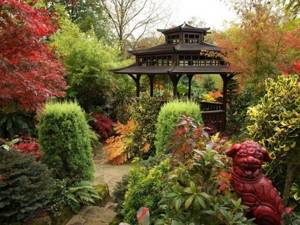
The turn has come to the Chinese style in landscape design, which belongs to the category of oriental landscape with hills. Let's add to this that a third of the entire site can be occupied by a pond. Gazebos, bridges, galleries and verandas are mandatory elements. The design welcomes bright colors, which cannot be said about the Japanese landscape style.
The range of vegetation is relatively wide. This includes evergreens and coniferous shrubs (trees). In the process of its creation, the natural features of the designed site are largely preserved.
Chinese style landscape design
Chinese style in landscape design is a fairly popular solution. The peculiarity of the garden is that it is landscape. And architecture and its forms have their own symbolic meaning. The main characteristic of the Chinese style is the presence of water and stone. No Chinese garden can do without a small reservoir or pond. However, they are not lined. A bridge can be built across the pond. Stone is another element that is created by nature. Entire compositions and gardens are made from it. It’s just important to place these very stones correctly. This is very important for Chinese culture.
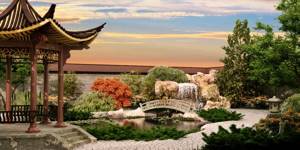
The principle of cultural gardening is to make it completely natural, spontaneous and arbitrary. After all, a garden is a miniature world, a kind of microuniverse, which affects the emotional state of the owner. In addition to water and stones, plants are used in the design:
- pine;
- bamboo;
- plum and peach, which are considered trees of happiness;
- poplar;
- willow;
- ginko;
- a small number of flowers.
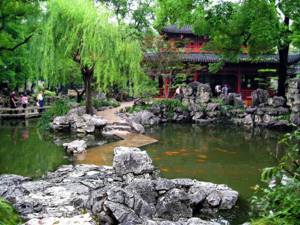
There may be no lawns here at all. Architecture is also characteristic of Chinese style. Gazebos, houses and other buildings are made in a special way. They have clear, straight lines, are quite simple and practical. The roof is very different, which can be straight or curved pyramidal.
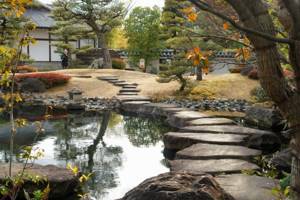
The charm of Mauritania
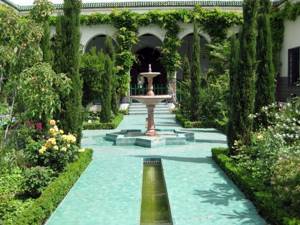
The Moorish style in landscape design combines the mystery of the East and European garden art. The style assumes the presence of a patio for arranging a patio. Mandatory elements are arches, pergolas and other structures for the growth of vines, grapes and climbing roses. All planted ornamental plants should not be trimmed - their natural form in the landscape is quite acceptable.
Minimalism
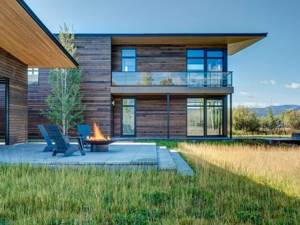
Laconism, simplicity and expressiveness are the key parameters of the minimalist style in landscape design. Its basis is an organic fusion of form and content. With a small number of elements inherent in the minimalist style, it has incredible expressiveness and beauty.
Features of the minimalist style
Despite all the apparent simplicity at first glance, organizing such a site is not so simple. A mandatory condition for creating a design is preliminary zoning, but landscape symmetry will not be necessary. Stairs, buildings, podiums and other similar elements are welcome. The design is dominated by cream, light terracotta, silver and white colors.
When developing a landscape design project, it is possible to use both artificial and natural materials. It is worth noting that the material used for all buildings must be the same, for example, all buildings and elements are made of brick, including even paths. There are no strict rules regarding vegetation. Here you can plant both fruit and coniferous trees: maple, birch, willow and other plants. With a small area, vertical landscaping is encouraged. The style is not characterized by a large number of decorative elements; small boulders, mirrors, metal balls, driftwood and others would be appropriate here.
The reservoir created within this style must have the correct geometric shape and fit perfectly into the overall landscape appearance.
Country
Country music is very popular at the moment. It became so widespread due to its simplicity of design and naturalness. It is characterized by the absence of clear lines.
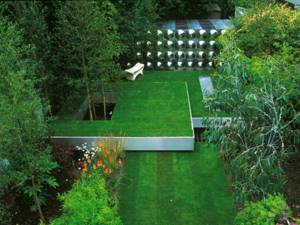
When decorating in a rustic style, you can use the freedom of imagination. The main thing is that in the end you should end up with a garden that is as close as possible to the rural type.
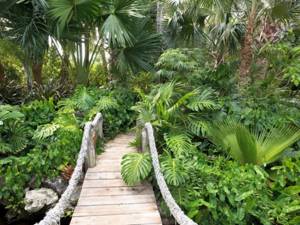
Country style design has several features:
- Square. The size of the plot is not important. The main thing is that the area is suitable for recreation and gardening.
- Use of environmentally friendly materials: wood, wicker, stones.
- Planting fruit trees and shrubs: apple, cherry, currant, etc.
- Decorative elements. You can use hedges, wells, benches, etc. in the design.
- If you plan to develop a reservoir, then you should use maximum naturalness (for example, a small pond overgrown with reeds).
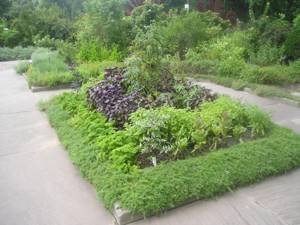
High tech
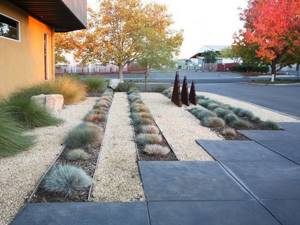
The high-tech style in landscape design can be classified as a modern trend, since it allows you to realize your wildest fantasies when arranging the landscape. This style does not require asymmetrical or symmetrical lines and decors. The main advantage of this landscape style is that caring for the site will not take much time, which will be an ideal solution for very busy people.
Features of high-tech landscape style
The style welcomes the use of metal, glass, polycarbonate, plastic and other modern materials.
The basis for arranging paths in such a landscape is white or colored gravel.
All plants are planted in flowerpots or containers of strict geometric shapes. You can plant pyramidal spruces, cypresses, thujas or boxwoods, and, using gardening tools, the plants should be given strict shapes. There is no place for bright and colorful colors in this style.
In terms of decoration, special attention is paid to lighting; modern lighting equipment with LED lighting is being introduced. Colored lighting and a uniformly illuminated area of the site are preferable. In some cases, it is possible to install solar-powered lighting.
In addition to lighting, it would not be a bad idea to decorate the area with glass and metal figures, for example, balls, cubes and other abstract figures.
High-tech style in landscape design
High-tech landscape design is a new direction. The style is appreciated for its advantages; it is comfortable, harmonious and easy to care for. For those who are busy, this is the best option, since it doesn’t take much time to maintain order.
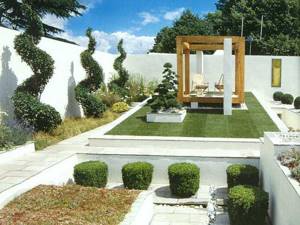
As for materials, modern materials are mainly used for landscapes, such as:
- concrete;
- plastic;
- mirrors;
- glass;
- metal.
As for the layout of the territory, these are clear lines. The paths are made zigzag and straight. Clearly shaped tiles are used to create. High tech can be either symmetrical or asymmetrical. They dilute everything with laconic-shaped trees, thuja, spruce and junipers. The flower beds are small, not variegated. Showy plants such as irises, hostas or ferns are suitable here.
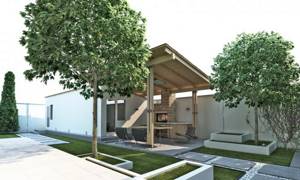
Mediterranean style
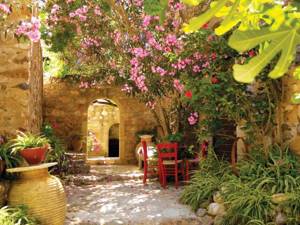
The wondrous natural beauty of the southern seas will not leave anyone indifferent. Colorful gardens with citrus and coniferous plants, successfully complemented by picturesque ponds and decorated with arches of various shapes, pergolas and grottoes, amaze the imagination.
But in northern latitudes, embodying the Mediterranean style in landscape design is a very difficult task. Reviving copies of subtropical plants on the site, adapted to the climate of St. Petersburg and the Leningrad region, will require a lot of effort and patience. For the sake of fairness, it is worth noting that style is built not only on green spaces. To achieve maximum resemblance of a site to gardens on the Mediterranean coast, design tricks and a whole arsenal of attributes are required.
Features of the Mediterranean landscape
The style welcomes relief areas, but in their absence, artificial hills, slopes and stairs can be made. It would be a good idea to allocate space for a patio, and a hedge will be an excellent solution for zoning and designing the entire area of the site. The Mediterranean style is rightfully considered the most picturesque and colorful in the field of landscape design. Colors and paints such as blue, orange, azure blue, white or sand are welcome.
The paths are landscaped with sea pebbles or natural stones.
The outdoor furniture installed is rattan with cushions painted in white and blue stripes. In this landscape style, preference is given to palms, citrus and olive trees, but in northern latitudes they can be replaced by evergreens, such as spruce, pine or juniper. Herbs and colorful flower beds are a feature of this style, and flowers in this design are purple, orange, red or blue. A good practice would be to plant them in groups.
Decorative elements of the style - garden figures, amphorae, wooden benches or antique dishes. A mandatory element is some kind of body of water: a stream, a waterfall or a lake.
Landscape Design Components
They are diverse; when considering them, it is better to combine them into groups:
- building;
- lawn coverings for gardens;
- green spaces;
- architectural forms of design.
Building
On the territory of the site there are always one or multi-story buildings, the architecture of which and their purpose are very different. At the center of the design project there should be a residential building, which is adjacent to the layout of the garden and vegetable garden. It is designed so that the strict unnatural lines of buildings are in harmony with the chaotic environment of the plant world. If the body of the building is white, then such a neutral color is easier to fit into the overall color of the landscape.
The compositional combination of buildings on a garden plot determines the spatial appearance of the landscape, the contrast of light and shadow.
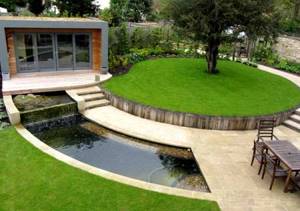
Option for designing a building in the landscape design of the site
This should be taken into account not only when setting up a vegetable garden, but when designing a small plot. Any orchard in landscape design needs sun.
Lawns
Types of lawns that are used to develop garden landscapes:
- English lawn, also called ground lawn. Caring for it is simple: fertilizing the soil, cutting, watering. As a rule, bushes, trees, stones and flower beds are not placed on it. This is the main, and in terms of scale, the largest design object for a landscape design garden. Therefore, it is usually located in the center of the design composition.
- Moorish or meadow lawn. It uses cereal perennial grasses with the addition of a small amount of seeds of wild flowers of the local region. In spring, summer and autumn they create a flowering meadow that requires virtually no constant care.
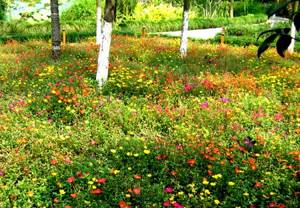
It is cut extremely rarely. And plants are selected that have different flowering periods. The corners of the garden landscape design, where there are coverings of the specified style, look festive and elegant. - An ordinary garden lawn. It is cut very rarely. Initially it resembles a piece of a vegetable garden. But after a while its vegetation becomes very dense, and after the first mowing it looks like a parterre lawn covering that can decorate various types of gardens in landscape design.
- Sports turf. Its main quality is increased resistance to trampling. For this purpose, cereals with appropriate properties are used. It is not as decorative as parterre or Moorish, but it costs more. It is used to equip stadiums with football fields, tennis courts and playgrounds.
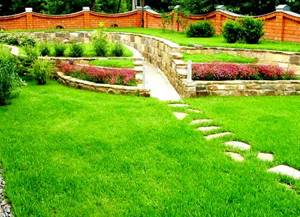
Design of a sports lawn in the garden landscape design - Natural lawn of the site. It looks simple and natural, like a garden area. Rich in herbs, which gives it a unique appearance. Once the grass is mowed, tall weeds become ground cover plants. This lawn covering will successfully decorate the landscape design of a coniferous garden.
Green spaces
A significant factor influencing the design of garden landscape design is climate. The most important component of the landscape—green vegetation—depends on it. They choose it for a garden plot depending on the shape, color scheme, and care features. True, some owners want to have a botanical corner with exotic plants in their home and build greenhouses for this purpose.
So that in winter the garden plot does not seem empty and abandoned, like the territory of a vegetable garden, evergreen plants are selected.
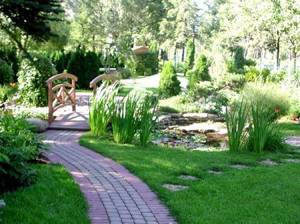
Green spaces in landscape design
In the middle zone, mainly pine and spruce trees are green in winter and summer. Therefore, the landscape design of private gardens is developed taking this circumstance into account. Green vegetation is formed by a botanical set of plants. The common background for them is lawn coverings, emphasizing specific styles of gardens in landscape design.
For example, an English lawn has a strict, flat surface of trimmed cereal grasses, while a Moorish lawn has various asymmetrical flower beds with bright colors. The Russian design genre is replete with a variety of herbs and trees, while the Japanese can do without them.
Fruit bushes cannot be trimmed, but a decorative fence made from botanical bushes can be turned into various shapes by trimming: a ball, a cube or an animal. Tall bushes for gardens are used as a landscape background or a green spruce hedge for a site.
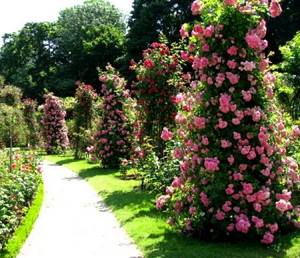
By cutting them you can create original design compositions with your own hands.
Water features
Water always attracts attention, regardless of whether it is in a dynamic or static state. The best garden in landscape design is one that has water features. Their types are as follows:
- streams;
- springs;
- waterfalls;
- park fountains;
- natural and artificial ponds.
The landscape design of small gardens is greatly enlivened if the botanical world of plants is complemented by some kind of water feature.

Option for designing a pond in the garden
Even springs, streams, cascades can be created artificially, not to mention fountains and reservoirs. The main rule when creating them with your own hands is to avoid symmetry so that everything looks natural, as in living nature.
Some hobbyists install outdoor garden aquariums in their gardens, the types of which are practically no different from ordinary aquarium tanks. They can have all the walls made of glass, but one is enough. It is quite difficult to create it with your own hands. In the middle zone, where winters can be harsh, all fish along with the grass are moved to warm rooms for the winter.
Provence style
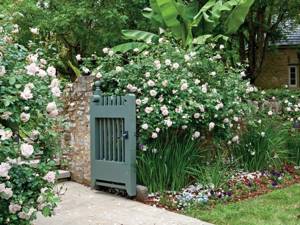
Landscape design in the Provence style has won the hearts of many connoisseurs of classics and pragmatism, because elaborate architecture and exotic plants have been replaced by simplicity and rustic simplicity. The name of the style personifies the visualization of a French village of the last century, where there is no place for luxury and originality in design.
Only modesty, simplicity and natural materials are appropriate here, because this is the charm of the naturalness of life. This style is an excellent solution for city residents who are looking for peace and harmony. The bottomless simplicity and naturalness of nature allows us to find the meaning of human existence.
Features of Provence style
The style does not use strict lines in design; rather, one can observe a certain negligence. Broken geometric lines are welcome.
In the decorating process, it is advisable to use an exclusively soft palette of white, pale pink, blue and light gray colors.
Natural materials, vintage decorative items, comfort and a warm atmosphere are the main features of the Provence style.
In terms of plants, the style assumes the presence of a brightly flowering front garden. A composition of calendula, marigolds, beans, zucchini, nasturtium, onions and sunflowers will look great. The paths should be paved with stone.
Landscape design in Provence style
Democratic, accessible, natural. This is the aroma of lavender, roses, excellent wine and sea breeze.
Character traits
- The presence of several fruit trees that are planted under the protection of the wall.
- All support structures are painted in soothing colors.
- The presence of garden furniture with antique motifs.
- Exposed stonework around the flower bed.
- Paths paved with natural gravel or natural stone.
- The main attribute of the Provence style is the presence of lavender.
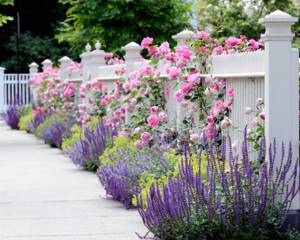
Lavender is often used in Provence style landscapes.
Unique Italy
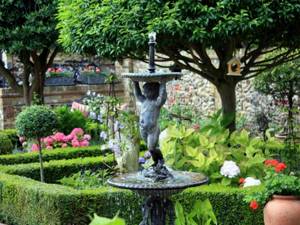
The Italian style in landscape design is an easily recognizable trend that offers to add the charm of a bright southern flavor to the basis of a classic design. This style of landscape design is a regular style, quite simple in planning, since it is subject to strict geometry and symmetry. It adds bright details, architectural accents and an unexpected variety of potted and tub plants to a rather pretentious and pompous base. No style treats silhouette and shape with such care, or presents small architectural forms and garden accessories as beautifully.
Characteristic features of the style
This style is ideal for areas with natural and sloping slopes. Both retaining walls and spacious terraces will look great here. A characteristic feature of the Italian style is a large number of stones, from which you can build a variety of objects, for example:
- fountains;
- cascades;
- balustrades;
- ramps;
- stairs;
- fences;
- pavilions.
Water plays one of the most important roles in this style. That is why a large number of babbling streams, fountains and ponds are welcome. Recreating such a landscape is not an easy task, since the garden will need to be located on a difficult terrain.
In this style, it is important to correctly arrange the stones so that the area does not resemble a place where stones accumulate.
The design picture is created along axes, on the main one of which there are parterre lawns, decorated with sculptures, flower beds and other elements of landscape design.
Plantings in bosquets will also look original.
The flat part of the site is arranged with stones from a semicircular wall, like an amphitheater. If it is necessary to organize a secluded place, an isolated corner of the garden is created.
There are special places for ponds and long straight paths lined with Italian mosaics. Sculptures in antique style, viewpoints and much more - all this has absorbed the Italian style in the landscape design of a personal plot.
Regular Landscape Design Styles
French style of landscape design
This style cannot but delight, because it is the very embodiment of luxury and elegance. It requires strict geometry so that the man-made nature of the created garden is deliberately emphasized, and there is not a single hint of the naturalness of the composition. Wide alleys, graceful figures, parterre lawns, beautiful flower beds - these are the main elements of this style. Strict symmetry must be observed in the layout: it is preferable to trim bushes in the form of geometric shapes or straight lines. True, such a garden will require a lot of maintenance.
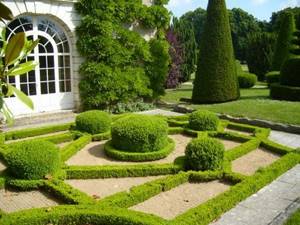
photo: French style of landscape design
A mandatory element in a French garden is a pond in the center of the composition, framed by fountains, cascades and sculptures. Lawns and flower beds are low, and bosquets contrast sharply with them - this is the name given to trees and shrubs that are trimmed to look like green walls. Paths lined with paving slabs with a green frame of low-growing shrubs will look very beautiful.
First, formulate your garden idea on paper: all elements must be arranged in strict order and be geometrically correct - build bends using a compass. Remember that in such a garden there should be two points - the upper one, where the house is located, from there there should be a view of the entire plot, and the lower one, where the main entrance is located. If you have a significant difference in elevation on your site, you can form a cascade of level terraces and connect them with stairs. An interesting solution would be to create labyrinths from thickets of honeysuckle, juniper or hazel. An elegant forged lattice can become a fence for such a garden.
Italian or Mediterranean style of landscape design
Initially, this style assumed the presence of strict geometric shapes and perpendicular paths. The center of the composition is a pond, around which there is a paved area and rare flower beds. The garden is surrounded by trimmed hedges or an elegant fence. A special solemnity can be given to the garden with the help of alleys and fountains, and spherical and cube-shaped shrubs and trees will become a harmonious frame for the paths.
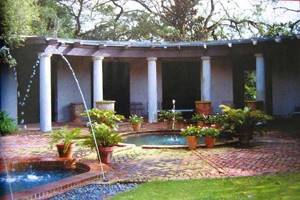
photo: Italian style of landscape design
Also a characteristic feature of this style is the patio - this is an elevated area located next to the house. Here you can place garden furniture, decorate the patio with sculptures and flowerpots with vegetation, and both coniferous and deciduous trees and shrubs are appropriate.
Moorish or Muslim garden
A characteristic feature of this style is the use of several squares, the center of the composition is a fountain or pond, and around it plants are planted in a geometric sequence and paths are laid out. Pools and fountains are often lined with marble or decorative glass; it is worth remembering that water in Islam is sacred, it is purification and life, without it the Garden of Eden is simply impossible to imagine.
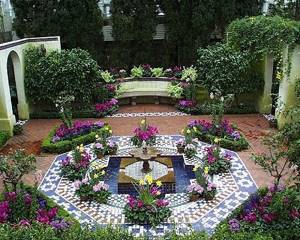
photo: Moorish style of landscape design
This garden is framed by galleries entwined with roses or wild grapes. A characteristic feature of such a garden is a corner of aromas where herbs are planted - such a heavenly place will definitely appeal to owners who adore spices and unusual aromas. Tile or mosaic paving is common in the yard - it is both simple and elegant.
The Spirit of Colonial America
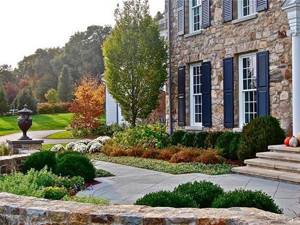
Recently, the colonial style in landscape design has been very popular because it is the optimal solution for small houses with a veranda. The veranda is surrounded by ivy, due to which the air in the room is always cool. This style does not adhere to strict rules and requirements for the use of exclusive materials. For example, here you can simply make do with a brick and a regular board. The result is a slightly careless design of the garden, as in colonial America, where this landscape style originates.
Features of the colonial style
Plants are placed in wooden tubs or white dishes. Wooden animal figures will also look original. A fountain, wicker benches or sun loungers will also not be superfluous.
This landscape ideally combines negligence and severity, simplicity and the spirit of freedom, which is emphasized by unusually trimmed plants. At first glance, everything may seem very simple, but achieving the perfect design harmony between chaos and relaxation in a landscape project of this style is not easy.
Mixed style
If you are not a supporter of any of the main style trends, then you will like the mixed style of landscape design. The essence of the mixed style is to design individual areas of the territory in your own unique style. Although it is worth noting that one landscape style should be predominant, the rest can smoothly transition from one to another. In addition, some landscape styles can be mixed with each other.
For example, you can build the following concept for landscape design:
- front area - regular style is used;
- recreation area - country;
- gardening area - French style.
An important condition is the absence of sharp transitions from one style to another.
ECO style – pristine nature
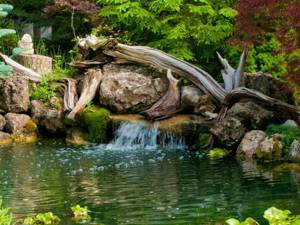
ECO style in landscape design is, first of all, maximum naturalness. The end result should completely resemble pristine nature, where there is no hint of human intervention. Based on the above, creating a design in this style will require a lot of effort.
Characteristic features of eco-style
The color tinting is natural.
Bridges made of boards, logs, grass, gravel, stones or bark are striking features of the ECO style.
When choosing plants, you should strictly adhere to the flora prevailing in the region. Lawns of wildflowers, forest plants and garden flowers are sure to create a pleasant and cozy atmosphere.
When choosing garden furniture, you should give preference to rough furniture, such as stumps, driftwood and other accessories of natural origin.
If there is a pond, it must contain living inhabitants.
Development Sequence
The owner of the site can develop the landscape design of the garden himself in order to embody his ideas and preferences. Implementing them with your own hands is possible in approximately the following sequence:
- site analysis;
- choice of design style;
- drawing up a general plan of the garden area;
- creating a landscape layout drawing with buildings, plantings, paths and other components;
- preparation of a design project for small architectural objects: gazebos, pergolas, bridges, steps, railings;
- layout, placement of landscape modules - already existing ready-made garden compositions;
- drawing up landscape lighting schemes, illumination of garden paths and automatic watering of garden vegetation and vegetable beds;
- 3D visualization of the finished landscape project.
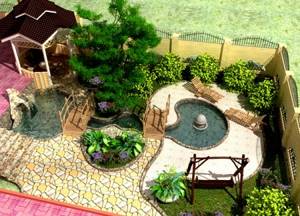
Site analysis
Before developing a landscape design for a garden plot, you should analyze everything that is available. Consider what the architecture of the buildings is and how to fit them into the overall landscape in the best possible way. This is also necessary in order to determine which landscape elements should be left unchanged and which should be changed or removed completely.
If there is a natural pond in the country, surrounded by pine trees, it, of course, should not be removed. It is enough to equip it with your own hands so that it is not in disrepair and fits into the modern ensemble. On the shore, a couple of large stones and a gazebo with a bridge will not be out of place, where it is pleasant to relax, enjoying the smell of a pine forest.
For the development of a landscape project, a very important factor is the existing terrain. The area of a small slope can be used for arranging a rock garden and cascading flower beds.
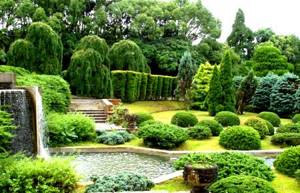
Using terrain in garden landscape design
On the slopes, panoramic arabesques of herbs and flowers, depicting various types of ornamental compositions, or animals, insects, birds, look great.
Before implementing your own ideas, it would not hurt to analyze such factors as determining the wind rose and the time at which individual areas are immersed in the shade. You need to know this when choosing plants: not everyone likes shade and quiet corners. If the garden soil dries out quickly in the sun, frequent watering of the vegetation will be required.
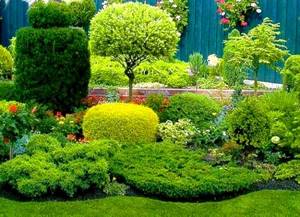
An important factor is the analysis of the soil of the site in order to identify its acidity and content of chemical elements. The composition of the soil may not be suitable for future vegetation. If this research is not carried out, then the reason why some types of green spaces cannot take root in a new garden does not immediately become clear.
Styles
Garden landscape design projects are developed in accordance with the chosen genre. The following landscape design styles are popular today:
- Italian;
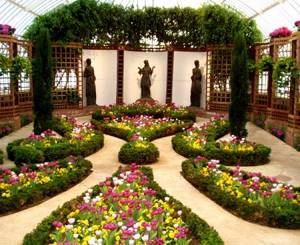
Italian style garden landscape design - English;
- French;
- Russian;
- country;
- Japanese.
The Italian design style is considered one of the oldest in Europe. The landscape consists of green spaces and a small courtyard, surrounded by a high blank wall or hedge. Owners and guests spend all their free time in the landscaped garden. Around there are garden furniture made from pallets, flowers and sculptures that decorate the architecture of the patio.
The most common and simple is Russian, and the most complex is Japanese style. The English style of garden design is no less attractive. It is dominated by natural motifs without noticeable human intervention, except for the lawn, which is always neatly trimmed.
The styles that originated in France have their own peculiarity: a constant emphasis on the subordination of nature to man.
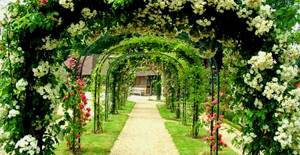
An example of the French style of landscape design in garden design
The design compositions are strictly symmetrical, the dense crown of trees and shrubs is always trimmed. Symmetry is emphasized by the arrangement of the vegetable garden, paths, flower beds and flower beds. It is observed by the architecture of small objects.
Today, styles are in fashion that evoke nostalgia for those times when quiet rural life prevailed on earth. These include such areas of landscape design as country, reminiscent of the time of the conquest of the American Wild West, as well as the Russian village genre. Both do not require large financial and labor costs, and green spaces do not need cutting. Both look great when decorating a small piece of land using pastoral motifs.
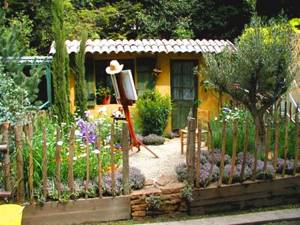
Exotic styles have become widespread. Some of them are characterized by bright colors, unusual shapes and bizarre combinations, characteristic of the gardens of South America and the African continent. It is quite difficult to reproduce them with your own hands in the latitudes of Eurasia.
Japanese style is also exotic. Unlike others, it is simple and at the same time mysterious, radiating peace and inner harmony. Taste and a sense of proportion are important to him. The landscape design of a Japanese garden does not allow for a symmetrical arrangement of decorative components. Each of its elements, be it a tree, a group of stones or a small pond, carries a semantic philosophical meaning.
Russian style of the 18th century
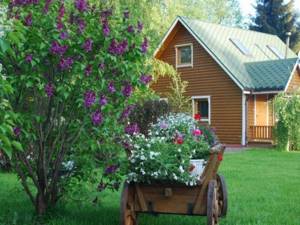
In landscape design, the Russian style is a mixture of features of other national styles borrowed from the cultures of Italy, England and France. Gradually, from this cocktail, seasoned with peasant and landowner traditions, a separate direction was formed, which has its own characteristic features.
Regular (classic)
This ancient Egyptian style is characterized by straight lines, a strict type of buildings and large space. It is also called French, architectural and classical. The regular style was first used in France during the reign of Louis XIV.

The main idea in landscape design of that time was to organize the flora and subordinate it to man.
Only round or oval-shaped fountains and ponds are used in the design. And all trees and shrubs are regularly trimmed to geometric shapes. This type of design became the basis for modern high-tech.
